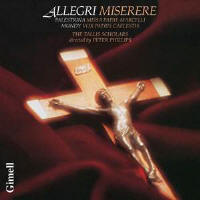Texte paru dans: / Appeared in: |
|
|
Reviewer: J.
F. Weber
The psalm and the Mass were heard on the Tallis Scholars’s first recording (7:3; CD in 9:6), recently reissued once more, and with the Stabat mater were made again in “Live in Rome,” recorded and filmed at St. Mary Major in Rome on the 400th anniversary of Palestrina’s death (18:3). Now, after hundreds of concert performances in over 25 years, Phillips has presented a mature interpretation of the two favorite works. The Allegri, despite numerous recordings by similar ensembles, is a signature work of theirs, and this is an outstanding presentation. The singing is of the ultimate assurance, and the engineering distinguishes the spatial arrangement even better than before. Most of all, the work is sung again at the end of the program in a more elaborately embellished version that Deborah Roberts has tried out repeatedly in concert. Embellishment was always the key to this work (I have recordings directed by Theobald Schrems and Bernhard Klebel that have no ornamentation, and one by Gerhard Weinberger that has no high Cs). In the second rendition, she embellishes the vocal line even more at each repetition, and the successive melodic lines are printed in the text. Another lovely feature of both versions is the tonus peregrinus psalm tone, which, we are told, soloist Andrew Carwood just happened to introduce. While this tone, which has a different reciting note for the second half of each verse, has only been used for the psalm In exitu Israel at Sunday Vespers, I find it more suitable in this context than the usual mode 2 tone always heard until now in this work. The major work remains the Palestrina Mass, by common estimate the composer’s masterpiece. I once heard it sung at a pontifical Mass in Aachen cathedral, an unforgettable experience at a time when the choir of men and boys was at their peak under Rudolf Pohl. My longtime favorite recorded version came from Westminster cathedral in London (11:6), sweeping a crowded field. This mixed vocal ensemble with two voices to a part makes a different effect than a choir, especially since the cathedral uses boys as trebles and altos. Yet the Tallis Scholars were magnificent in their “Live in Rome” performance, and this version reflects that achievement and the intervening concert performances as well. Of the two fillers, Stabat mater is widely regarded as Palestrina’s finest motet, Set for two four-voice choirs, it was a late, mature work that showed his awareness of the Venetian style. Tu es Petrus is a six-voice work that furnished the basis for a Mass by the composer (both motet and Mass were recorded by the the King’s College Choir and others). Altogether, this is a well-filled disc of multi-voiced polyphony, an achievement that reminds us of the group’s long line of successes. No one will be disappointed by this disc. | |
|
|
|
|
|
|
|
Cliquez l'un ou l'autre
bouton pour découvrir bien d'autres critiques de CD |
|



